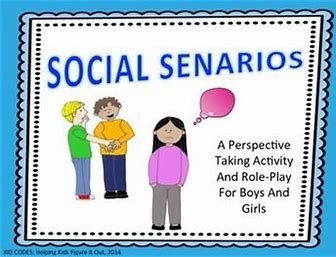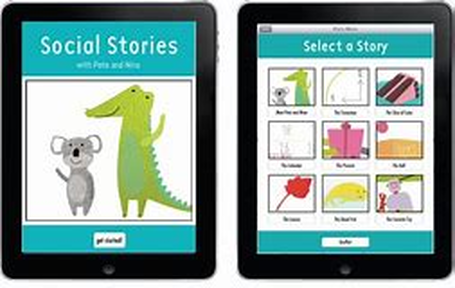SOCIAL STORIES Visual Support – Part 1 of 3
#SocialStories
When to use Social Stories –
Social Stories can be made to be simple or more complex for those with both low functioning and high functioning autism. These stories can be shared by the general population, as well. One can create further theme development, allowing for extended activities of modeling, shaping, or role-playing. This however, may require the person’s in-depth self-evaluation, perspective-taking and Theory of Mind (ToM) in order to understand the expectations hoped for. Also, consider the complexity of change needed and the degree to which the undesirable behavior needs to be extinguished.
- What’s in it for me?
- How come “sister” doesn’t have to do it?
- Who made these rules?
- Why can’t I do what I want to do?
- Where did (cause of change) come from?
- When can I stop doing this?
#ChangeBehavior
Before anyone is able to change a behavior, routine, or schedule, you need to know where they are in their basic understanding. A ‘baseline’ for learning that new skill needs to be established. And, when you know what they already have learned, you can do what I call ‘Starting Where They Are’. Which was the thesis for my 2013 Master’s Degree in Special Education. In addition to this, one needs to know if the person understands someone else’s perspective. Do they have Theory of Mind (ToM)?
Cariello & Capell (2015), Carrie tells us that her autistic son Jack’s biggest issue was with theory of mind, or the concept that other people have thoughts, ideas, or opinions that are different from his own.
Let’s say, she tells us, that Jack really, really, really loves hot chocolate. He thinks and talks a lot about hot chocolate: which brand is his favorite, and the best marshmallows to layer on the top.
And then one afternoon you casually remark that you don’t really care for hot chocolate. That you had hot chocolate once when you were a little girl and it burned your mouth and you’ve never really liked it since.
Right away young Jack’s brain begins to short-circuit in a way that suggests his head may explode. He starts to jump and stim and chant things like, “How can you NOT like hot chocolate I LOVE hot chocolate, hot chocolate, hot chocolate, I can’t believe you don’t like hot chocolate, HOT CHOCOLATE!”
This can go on for hours. And if his own head does NOT, in fact, explode – if it stays firmly attached to his neck in one round piece – he will do everything in his power to make sure that your head explodes instead.
< My Thoughts > “‘Theory of Mind’ is thinking that everyone is having the same ‘sensory experience’ that you are.”
#TheoryOfMind
Theory of Mind is thinking that “…everyone sees and feels and likes the same things that you do.” When children find it difficult (if NOT impossible) to understand the emotions, intentions and behaviors of other people, they are said to lack ‘theory of mind’ (ToM). We don’t always know to what extent a child can ‘take’ another’s perspective; therefore, we may want to add ‘Social Stories’ to introduce the concept of ‘perspective’, because they can include ToM.
Sicile-Kira (2014) says that, “Social relationships are important to all people, yet are difficult for many on the autism spectrum to develop naturally.” “…having social skills, knowing about expected yet often unstated rules of behavior, and social boundaries.” “…there are different ways of teaching what is needed to be learned about relationships.” Some of the things she suggests are – Social Skills Training, Social Stories, Social Thinking, and Hidden Rules such as ‘assumed knowledge’, social hierarchies, and experiencing expected/unexpected situations.
< My Thoughts > Social Stories are widely used for teaching awareness about… “expected/unexpected situations.”
Consider creating a Social Story just for fun, or for building skills, introducing change, or what to expect in social interactions. You can do this through Comic Strips, Storyboards, or Social Stories; enhancing all of these with age-appropriate Visuals
REFERENCES used here:
Cariello, C. & Capell, J. (2015). Someone I’m With Has Autism; eBook Edition.
Sicile-Kira, C. (2014). Autism Spectrum Disorder (revised): The Complete Guide to Understanding Autism; New York, New York: Penguin Random House Company.
#ASD #BLOG
SOCIAL STORIES Visual Support – Part 2 of 3
#SocialStory
SOCIAL STORIES – Part 2 of 3
A favorite of parents and teachers for learning self-awareness would by teaching social skills through ‘Social Stories’. Carol Gray was the official originator of ‘Social Stories’ and you can find much online to learn more about her methods. Versions of these teacher/parent–made stories have been used the world over, in some form or another. You don’t have to take a course or follow a certain protocol in order to create them.
For instance if you are going to take your child to the park, you could create a little story to show them what to do or expect to see there. Here is an example of what the authors used as ‘Social Story’ text for a preschool boy who was mostly reclusive, but became animated during Preschool snacktime. #Snacktime
We have snacktime at school
Friends talk & share snacks
Some friends say “Hi”
Some friends ask for a drink
Some friends ask for more snacks
I can say “Hi” to my friends
I can ask for a drink
I can ask for more snacks
Friends are happy at snacktime!
The authors commented that many children need to have pictures added to the story, these can be real-time or Clip Art. Also many need to have verbal prompts added for emphasis and to increase success.
< My Thoughts > Use your creative license here. Children with autism or autism-like behavior take in a lot more than parents are aware. They often use peripheral vision to watch your every move, but you’ll never catch them looking at you. So, create this social stories within his or her view. Best of all scenarios would be to have them choose a picture or help you in some way, however small. Of course, the latest twist on Carol Gray’s Social Stories is the APP available so that you can create, present, and store your child’s stories on your iPad or iPhone. Smiles.
Reference used here was:
Crozier, S & Tincani, M. (2006). Effects of Social Stories on Prosocial Behavior of Preschool Children with Autism Spectrum Disorder; Journal of Autism Developmental Disorders; V37, p.1803 - 1814.
NEXT: SOCIAL STORIES – Part 3 of 3








 RSS Feed
RSS Feed